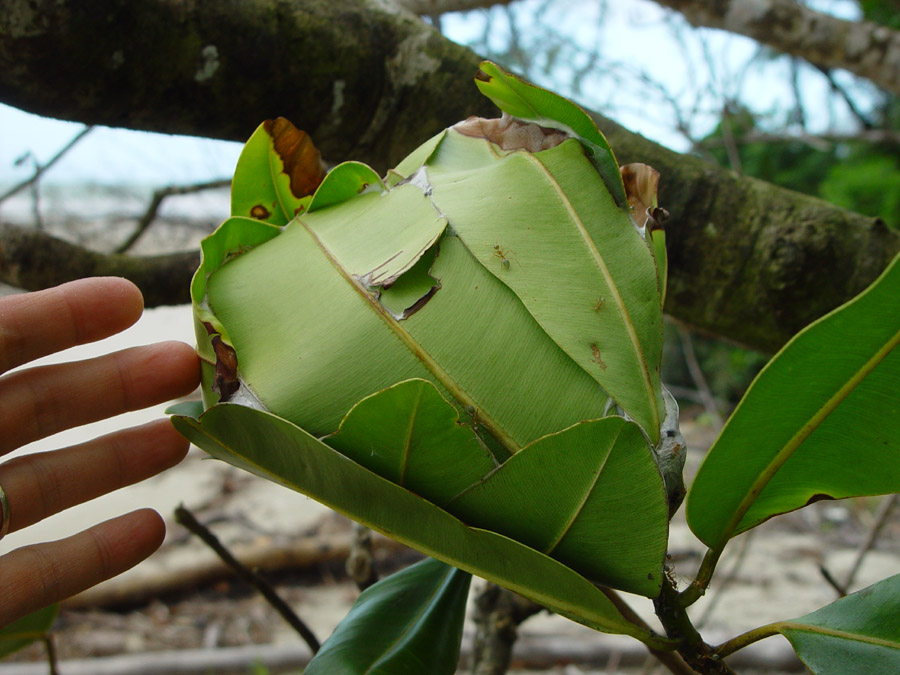More specifically, this blog is about their colony structure. And more specifically, the colony structure of those ants who build their homes underground. Ants build many kinds of houses, which also double as fortresses, to live in and their structure can vary greatly from species-to-species.
Some ants build bivouacs which are "a structure formed by migratory driver ant and army ant colonies. A bivouac nest is constructed out of the living ant workers' own bodies to protect the queen and larvae, and is later deconstructed as the ants move on." (3)
 |
| A BIVOUAC |
Still others build nest of leaves woven together with silk threads.

And as you will see in the videos below, there are many ants that build their homes underground and the variation, both in size and structure, of these underground engineering feats is staggering, with each species and colony doing things slightly differently.
These homes that ants build are clean. You'd think that with such high numbers, sometimes in the millions or billions, of individuals living in such close proximity there would be lots of diseases and epidemics, but ants are very clean, keeping their colonies hygienic, sealing off parts of the colony that become infected and quarantining individuals who get sick. They even know how to use antibiotics, gathering plants with anitmicrobial activity to scrub down their colonies in the event they get infected. They also have rooms where waste goes and when they're full they are sealed off.
Ants also build homes that are buffered against environmental fluctuations with climate control. Irrespective of what's going on outside an ant colony tends to have a steady air circulation and constant humidity and temperature because of the engineering genius of these structures. This has allowed ants to live in the barrenest deserts and above the Arctic Circle.
What's more, ant colonies tend to grow like trees, in the sense that just as trees gain more rings as they age, ant colonies tend to get bigger and bigger, with more compartments and/or multiple interconnected colonies, as the colony ages. Some ant colonies are measured to be over 800 years old!!! Colonies can outlive their members just as nations can. This being the case while the average worker only lives a few weeks to a few months while the queen can live for decades.
Many ant societies have a division of labor of varying complexity. Some with general workers, nurses, cleaners, guards, police, managers/supervisors, queens and drones, tunnel miners, scouts, herders, gardeners, food gatherers, hunters etc.. Similarly, their underground colony structures tend to be divided up into specialized compartments.

From storage rooms to trash rooms, the queens' egg laying quarters to the nursery, the room where aphids are kept to rest rooms, to sleeping quarters, to processing rooms and quarantine rooms, etc., etc., etc.. An ant colony is pretty much like a city. And not all of these cities are so small.
Some ant colonies have been found that are over 670 acres in size (over a square mile!)! One in Australia is over 62 miles wide!! These colonies have billions of ants and thousands or even millions of queens. And somehow, through leaving chemical scents and feeling each other with their antennae all of these ants are able to figure out who belongs to their colony and who doesn't, immediately attacking intruders.

More recently, nation like conglomerates of non-aggressive colonies have been found that stretch over 3000 miles in Europe, 500 miles in California and a 100 miles in Japan. If an ant is taken from one end and another from one hundred miles away meet they won't attack each other, instead treating one another as if they were from the same colony or nation.
For a long time people wondered about what ants were doing underground. What their underground houses looked like. How they survived rainstorms and snowstorms. A technique was developed to cast the structure of these underground colonies.
I don't know about the morality of destroying all of the ants in the process of making these casts, (some of the makers claim that they only cast molds when the colonies are abandoned or if the colony is destined for extermination because it is a nuisance, but hopefully in the future there will be more humane ways of figuring out their structure without having to kill whole colonies of ants), but the videos below shed light on ants and their underground abodes like nothing I've ever seen before. (It seems to become more of an ethical dilemma for me, the more I learn about how magnificent these creatures are). These casts magnificently show what the structure of the underground colonies are in all their intricacies. These videos show the amazing engineering feats that ants are pulling off to survive the conditions thrown at them by the world.
The following videos show castings of the underground networks made by the colonies of various species of ant. They are all quite remarkable and show how different species evolved different aesthetics and architectures depending on their environment and societal demands. Especially for the fourth video it is almost impossible to believe that such small creatures could pull off such building feats and it is truly mysterious to think what these creatures' lives must be like under the surface. Also, many of them have such stunning architecture it calls into question the definition of intelligence and what can be made possible when beings work together. Each is a few minutes long, but all are worth watching.
Here are some other images of ant colonies cast by Walter Tschinkel:

Besides art, I don't know what to call some of these marvels. One has to wonder if these structures don't shed some light on the psychology of ants much like art can tell us something about the psychological state of humans.


Seth Commichaux
Sources:
1) http://www.cmoe.com/blog/the-team-approach-with-teamwork-anything-is-possible.htm
2) http://news.bbc.co.uk/earth/hi/earth_news/newsid_8127000/8127519.stm
3) http://en.wikipedia.org/wiki/Bivouac_%28ants%29
No comments:
Post a Comment